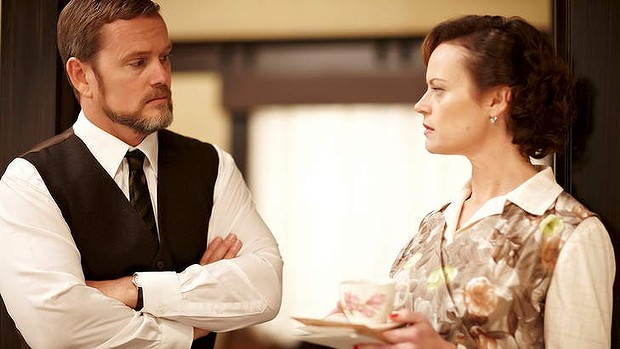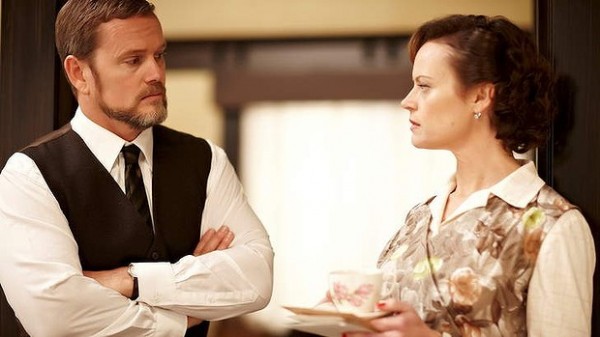Lucien. Could be Lucifer’s twin brother – the less evil one. It also carries the sense of the ancient Roman, a patrician family name. Respectable and old school. Dr Lucien Blake, resplendent in salt-and-pepper beard, dapper suit, clenching his leather Gladstone bag is quit the picture. He exhibits an air of fuss and fluster, rather a conservative manner bordering on pomposity at times, as one would expect from a GP, while his concern, emotional balance and bedside manner reflect his Japanese POW trauma survival. The remarkable aspect of all this is that Dr Blake is played by Craig McLachlan… from Neighbours… and played well.
What a transformation. His surprisingly convincing performance was impressive perhaps because of the total transformation. I went a few minutes before I realised that was him in the lead role, he was practically unrecognisable. The last thing I remember of him was the mid 90s or thereabouts and he was doing musicals and was on a career trajectory set to be some sort of latter day David Cassidy hauling around the Aussie David Hasslehoff surfer dude baggage with him until his inevitable drug-binge/rehab period where he goes into obscurity. I’m not sure how much of that was true of him as I wasn’t paying attention for the last 20 years. I suppose blondes get written-off all the time as incapable of serious material. Aussie murder mystery period dramas are still relative obscurity, but he has certainly mastered serious.
It is a study in serious. I counted upwards of two dozen eyebrow furrowings at least in episode two. That’s a furrowing to raised eyebrow ratio of 3:1 – that’s some serious tormented drama happening right there. No flash-backs to the horrendous torture of Tenko time either – at least not yet. At the moment that’s supplied by another eyebrow twitch, a slow draw of breath, a flinch of tension in the jaw, or the focus of his eyes becoming a stare into the distance, the past. The unresolved missing status of his Chinese wife and their child from the fall of Singapore will deliver over time, but at episode two I found the character development and their associated sub-plots to be receiving more attention than the headline homicide.
The setting is Ballarat, in country Victoria, north of Melbourne, 1959. Dr Blake is the on-call police surgeon. Coronial issues, the results of police brutality and so on in a provincial city would be his stock and trade as consultant to the constabulary, but the radiation poisoning from the British atomic testing in South Australia in the last programme demonstrate a wide possibility of story lines that exist in the Australian context of historical drama.
Before mentioning the other characters however a comparison should be made here with the other Victorian detective drama from the ABC, Miss Fisher’s Murder Mysteries, which it largely adheres in terms of genre convention. Phryne being the weird name instead of Lucien – which goes back, like the chamber orchestra style music, to the British Hercule Poirot series starring David Suchet (having ended last year after running since 1989 I note that ITV are partners in both that series and Dr Blake). Miss Fisher is primarily a women’s affair as Dr Blake is the masculine. Fisher was written by and made by and for women, which may explain why there are more outfit changes than Lady Gaga, and Blake by and for men which explains why everyone looks like they’re at a funeral.
I doubt very much from the modest sets and situations they have sought to portray that Dr Blake commanded anything as much as the million dollars an episode that Miss Fisher cost to produce. Blake’s world is a drab post-war black and white bland where every colour seems washed-out. (People who lived through those times inform me it really was that dull). Street scenes in 1950s Ballarat are limited to a few people in hats and the local Holden Club parking a couple of FC’s in shot, while Melbourne in Fisher’s roaring 20s is a sumptuous extravaganza of costume and art direction.
While the dour Dr Blake drowns his sorrows in Scotch at the Old Colonists’ Club where he exchanges minimal conversation with some army cobber who looks like Ernest Borgnine, Miss Fisher is dashing about heroically with her dashing and heroic assistant; never letting her nursing experience in the Great War depress those around her as Dr Blake looks like he will be doing for this series. I can hear him now, in the best traditions of British period dramas, thumping the Times (or in his case The Age) against his thigh and in exasperation exclaiming ‘It’s this damned war!”.
The strongest similarity is the importance of the household to the show’s eponymous character: housemaids, boarders and sundry; followed by the relationship with the police chief and their assistant. Dr Blake must deal with Inspector Matthews (Joel Tobeck being a New Zealander has the least amount of Aussie drawl going on) and he has his side-kick, a young constable, who will doubtless be having some sort of romantic interest with whoever the young women on Dr Blake’s side turns out to be (that’s how it worked for Miss Fisher anyway and I can’t see that formula being broken here).
So, it’s a bit conventional and a bit blokey. In one scene the victim of a police bashing is given a bottle of whatever, a handshake, and an apology from a cop for having beaten the snot out of him – mistakenly of course – the previous day. I’m not sure that has ever happened in Victoria or anywhere else. Like ANZAC Day and cold beer some things never change. The police have to be decent underneath despite their animalistic propensity.
Maybe it’s the contemporary writing, but the “one punch” killings in Australia over the past couple of years made an appearance last week and it would not be unexpected to see some more modern issues being used in the stories. The 50’s styles CSI – tracing paper and luminol etc – always raise a smile. How far we have come – it’s a miracle any crime was ever solved if we are to believe the state of technology back then. Gumshoe tough guy stuff beats forensic expert stuff for better viewing though; there are only so many montages of computer and lab work a viewer can tolerate – Dr Blake seems to appreciate that.
It is possible, since they are both ABC shows that Miss Fisher of late 1920s Melbourne will go on to collaborate with a late 1950s Dr Blake. They would be approximately the same age.






